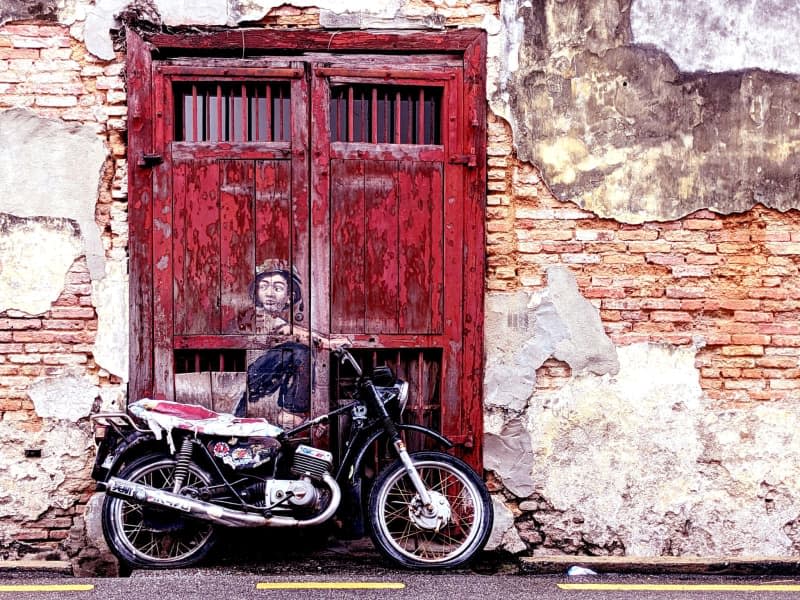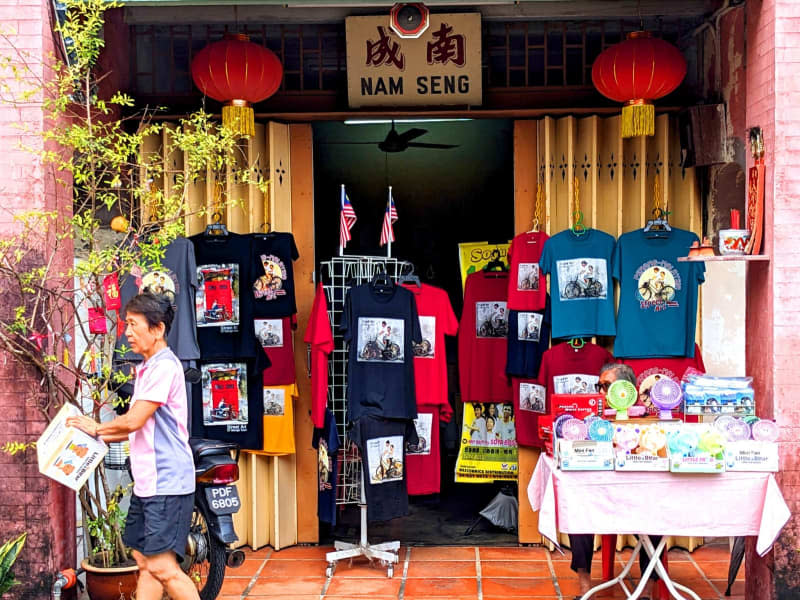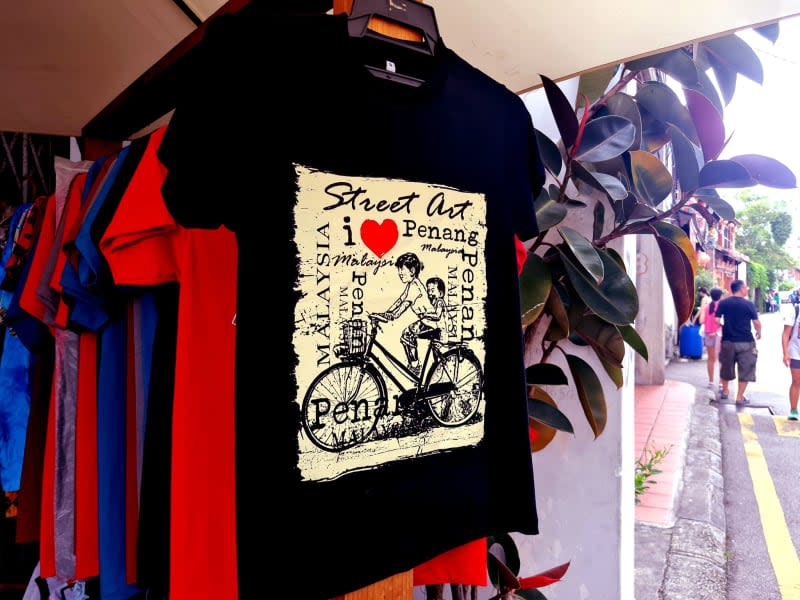In a world where walls divide, the street art of George Town unites

In the heart of Malaysia, where the azure waters meet the vibrant hues of tradition, lies a canvas unlike any other – the streets of George Town, Penang.
Here, every cobblestone whispers tales of the past, but it is the walls that truly sing. A mural symphony, birthed from the imagination of Lithuanian artist Ernest Zacharevic in 2012, has turned Penang into a living, breathing art gallery under the open sky.
Picture this: Strolling through the UNESCO World Heritage-listed streets, where each corner reveals a burst of colour and a story waiting to be told. The street art of Penang is not merely paint on walls. It is a dance of tradition, history, and contemporary issues that unfolds before your eyes.
Tourists swarm the streets of Penang to embark on a unique treasure hunt, armed not with a map of buried gold but one that unveils the city's vibrant street art. The popularity of these murals has given rise to detailed street art maps, guiding enthusiasts through the labyrinth of George Town's alleys and lanes.
Nestled on the north-west coast of Malaysia, Penang holds a storied past. Once a crucial trading post under British rule, the island attracted merchants from Europe, China, and India.
The strategic location and cultural amalgamation have rendered Penang's history unique. Its capital, George Town, is renowned for its well-preserved colonial architecture, a testament to its multicultural past.
The city's recognition by UNESCO as a World Heritage Site is rooted in its diverse cultural influences, historical significance, and architectural wonders.
Today, Zacharevic's murals on Penang's streets are joined by a mosaic of other works of street art, contributing to its status as a global street art destination. As visitors explore the vibrant alleys, they delve into a living canvas that narrates Penang's journey from a bustling trading hub to a cultural haven.
"Using a map is like going treasure hunting. The only difference is to actually find each street art on the list and ticking it off," said 36-year-old Japanese tourist Aiko Matsumura.
Armed with cameras and a spirit of exploration, visitors traverse the streets, ticking off each masterpiece like items on a checklist. It is a picturesque journey where every corner reveals a new chapter in Penang's artistic narrative.
Some tourists, captivated by the whimsical characters and thought-provoking scenes, aim for the perfect photo-op, creating a personal gallery of memories amid the open-air exhibition.
Yet, the allure goes beyond the visual delight. Penang's street art is not just an Instagrammable moment; it is a plunge into history and culture. Each mural is a snippet of Penang's multifaceted identity, and curious tourists often find themselves unravelling the rich tapestry of the city's past.
It is not uncommon to see visitors engaged in animated conversations with locals, eager to understand the cultural nuances and historical anecdotes behind the vibrant brushstrokes. The walls of George Town, once mere dividers of space, have become an interactive canvas, connecting tourists with the soul of Penang.
"There are so many street arts here. Some are really exquisite while some are normal. Regardless, I feel all have their own unique strokes and have different stories behind them," says 65-year-old Kirsten Muller from Austria.
"The most interesting thing is to understand the story behind each work of art. Sometimes, we use the internet to find out more about the stories. Sometimes, some of the backgrounds are included on the art itself. It’s fascinating to see Penang for what it truly is behind these stories."
As we navigate the streets, we witness a symbiotic dance between tradition and modernity. The murals are not frozen relics; they are living expressions that mirror Penang's heartbeat. The brushstrokes become conduits, seamlessly intertwining local folklore, historical anecdotes, and contemporary issues.
But why here? What links the UNESCO heritage status of Penang to these vibrant strokes? Much like a seasoned chef crafting a masterpiece, Zacharevic blended the historical and cultural ingredients of Penang into his art.
The UNESCO recognition, bestowed upon George Town in 2008, serves as a nod to the city's commitment to preserving its unique blend of cultures.
The 1986 Lithunian-born artist, armed with brushes and boundless creativity, breathed life into these walls, transforming them into portals to another time. He rose to international acclaim in 2012 when commissioned to create a spellbinding series of six street art murals for the George Town Festival in Penang.
Since that momentous year, the allure of Penang's street art movement has remained unwavering, a perpetually ascending crescendo in the symphony of artistic fascination. The murals have become not just a form of expression but guardians of a heritage that refuses to be forgotten.
A whimsical mural of children on a bicycle greets you like an old friend, evoking carefree days when laughter echoed through the air, just like a thought-provoking mural of little children on a swing.
"Times have changed but Penang will always be Penang. No matter where we go around the Penang Island, we can still see a mixture of tradition and culture despite modernisation that surrounds us," says 78-year-old Penang resident, V. Karuppiah.
During a 2016 interview with TimeOut, Zacharevic revealed that what was initially conceived as a short visit to Penang, a casual sojourn to "hang out (with his friend) for a bit," took an unforeseen turn, transforming into a four-year stay. This extended period eventually led to a significant life event for Zacharevic, as he tied the knot with Sheena Liam, the former Malaysian winner of Asia’s Next Top Model, in 2018.
Comparisons with other street art around the world pale in the face of Penang's living walls. While the world may boast larger canvases and grander strokes, Penang's murals wear the patina of time and tell tales etched in the very bricks of George Town.
Similar to Berlin in Germany, Penang had experienced significant historical and cultural shifts. Such backdrop is reflected in the street art found throughout the city, the visual commentary on the evolution of both cities.
While Berlin's street art often mirrors the complexities of the country's history, featuring larger-than-life murals charged with political and social narratives, Penang's street art is a testament to a city that gracefully balances on the tightrope between tradition and modernity.
These are not mere works of art; they is a mirror weaving intricate tales of local culture, folklore and contemporary issues on a more intimate scale, inviting viewers to gaze into Penang island’s very soul.
In a world where walls often divide, Penang's street art unites. It invites both residents and tourists to join the dance, to be part of a narrative that transcends time and culture through Art.
The murals will be the guide as you wander through the streets of Penang, immersing yourself in the enchanting tales that are waiting to be discovered – with stories that unmask Penang as a city where the past and present coalesce in vibrant harmony.



